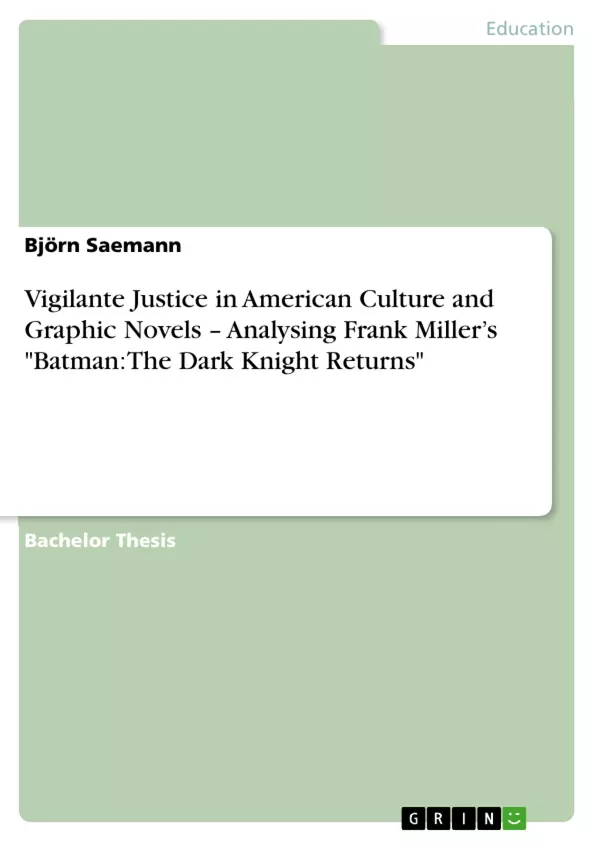
Vigilante Justice in American Culture and Graphic Novels – Analysing Frank Miller’s "Batman: The Dark Knight Returns"
Bachelorarbeit, 2009
28 Seiten, Note: 1,0
Didaktik für das Fach Englisch - Pädagogik, Sprachwissenschaft
Leseprobe
Table of Contents
- 1. Introduction
- 2. The history and definition of Comics and Graphic Novels
- 3. Batman – who he is and how he came to be
- 3.1 Batman as the Dark Knight
- 4. Summary of The Dark Knight Returns
- 5. Vigilantism
- 5.1 What is vigilantism?
- 5.2 Vigilantism in the United States
- 5.3 Bruce Wayne's motivation to become the Caped Crusader
- 5.4 Is Batman a true vigilante?
- 5.5 Can Batman's vigilantism be morally justified?
Objectives and Key Themes
This paper analyzes Frank Miller's Batman: The Dark Knight Returns, examining the theme of vigilante justice within the context of American culture and graphic novels. The objective is to explore the moral and legal ambiguities surrounding vigilantism, using Batman as a case study to understand its enduring fascination.
- The definition and history of comics and graphic novels as a medium.
- The origins and evolution of Batman as a character, focusing on his portrayal as the "Dark Knight."
- A detailed examination of vigilantism, its historical context in the United States, and its various definitions.
- An analysis of Bruce Wayne's motivations for becoming Batman and the moral justifications (or lack thereof) for his actions.
- The depiction of vigilante justice in The Dark Knight Returns and its implications.
Chapter Summaries
1. Introduction: This introductory chapter sets the stage for the thesis by establishing the long history of vigilantism in the United States, ranging from lynchings to modern-day groups like the Guardian Angels. It highlights the inherent conflict between legal and moral justifications for vigilante actions, framing Batman as a compelling example to explore this conflict. The essay outlines its structure, promising to delve into the history of comics and graphic novels, Batman's origins, and a comprehensive examination of vigilantism, culminating in an analysis of Batman's actions.
2. The history and definition of Comics and Graphic Novels: This chapter tackles the complex issue of defining "comics" and "graphic novels." It engages with Scott McCloud's concept of "sequential art," tracing the evolution of the medium from its early forms to the emergence of the "graphic novel" as a more serious and respected art form. The chapter addresses the negative connotations associated with the term "comics" and how Eisner's A Contract with God helped elevate the medium's perception. It concludes by arguing that comics are a unique hybrid of literature and art.
3. Batman – who he is and how he came to be: This chapter details Batman's origin story, acknowledging the variations across different iterations. It focuses primarily on the version presented in The Dark Knight Returns, tracing Bruce Wayne's transformation from a traumatized child to the vigilante Batman after witnessing his parents' murder. The chapter describes his costume, his headquarters (the Batcave), and his lack of superpowers, emphasizing his reliance on intellect, physical prowess, and technology.
3.1 Batman as the Dark Knight: This subchapter explores the evolution of Batman's portrayal, contrasting earlier, less morally nuanced versions with the more serious and realistic "Dark Knight" interpretation popularized by Frank Miller. It highlights the impact of Miller's work on subsequent Batman adaptations, noting the commercial failure of attempts to return to a lighter, campier style and the success of Christopher Nolan's film series in embracing a darker, more grounded portrayal.
4. Summary of The Dark Knight Returns: This chapter summarizes the plot of Frank Miller's The Dark Knight Returns. It covers Batman's return from retirement, his conflict with the Mutants and Two-Face, the emergence of a new Robin, and his final confrontation with the Joker. The chapter also touches upon the political themes of the story, including the conflict between Batman and the authorities, and the apocalyptic conclusion.
5. Vigilantism: This chapter provides a thorough examination of vigilantism, drawing upon definitions by Burrows and Johnston, and further refined by Dumsday. It differentiates between classic and neo-vigilantism, highlighting the key elements that define this phenomenon. The chapter explores the ethical and legal complexities of vigilantism, considering the different scenarios in which it might be justifiable or not.
5.1 What is vigilantism?: This section delves into the definitions of vigilantism, comparing and contrasting the approaches of different scholars. It emphasizes the criteria for classifying an action as vigilantism, considering factors such as organization, premeditation, the use of force, and the motivations behind the actions. The ambiguity surrounding the state’s involvement in vigilante acts is also discussed.
5.2 Vigilantism in the United States: This section offers a historical overview of vigilantism in the United States, starting with the frontier era and moving through the phenomenon of lynching. It explores the role of vigilantism in social control, citing examples like the Ku Klux Klan, and connects this history to contemporary vigilante groups such as the Minutemen and the Guardian Angels. The chapter examines the legal context of vigilantism in the US, referring to the Castle Doctrine and other laws that implicitly or explicitly encourage self-defense.
5.3 Bruce Wayne's motivation to become the Caped Crusader: This section analyzes Bruce Wayne's motivations for becoming Batman. It connects his actions to the failings of Gotham's institutions, emphasizing corruption and the inability of the authorities to maintain law and order. The chapter highlights Bruce's personal hatred for criminals and examines his justifications for his actions.
5.4 Is Batman a true vigilante?: This section applies the previously established criteria for vigilantism to Batman's actions in The Dark Knight Returns, concluding that he indeed qualifies as a vigilante based on his organization, methods, and motivations.
5.5 Can Batman's vigilantism be morally justified?: This section evaluates the moral permissibility of Batman's vigilantism, considering Dumsday's framework for evaluating the justifications of crime-control vigilantism. It considers the context of Gotham City's corrupt institutions and discusses the ethical implications of Batman's actions, including his use of force and his potential for pre-emptive strikes.
Keywords
Vigilante justice, Batman, The Dark Knight Returns, Frank Miller, graphic novels, comics, American culture, moral ambiguity, legal permissibility, crime control, social control, Castle Doctrine, Ku Klux Klan, Guardian Angels, superheroes.
Frequently Asked Questions: Analysis of Frank Miller's "The Dark Knight Returns"
What is the overall topic of this analysis?
This analysis explores the theme of vigilante justice in Frank Miller's Batman: The Dark Knight Returns, examining its moral and legal ambiguities within the context of American culture and the graphic novel medium. It uses Batman as a case study to understand the enduring fascination with vigilantism.
What are the key themes covered in the analysis?
Key themes include the definition and history of comics and graphic novels, the origins and evolution of Batman as the "Dark Knight," a detailed examination of vigilantism (its history in the US and various definitions), an analysis of Bruce Wayne's motivations for becoming Batman and the moral justifications for his actions, and a depiction of vigilante justice in The Dark Knight Returns and its implications.
What aspects of Batman are analyzed in this paper?
The analysis delves into Batman's origin story, focusing on his portrayal in The Dark Knight Returns, tracing his transformation from a traumatized child to the vigilante Batman. It examines his costume, headquarters (the Batcave), lack of superpowers, and reliance on intellect, physical prowess, and technology. The evolution of Batman's portrayal, from earlier, less morally nuanced versions to the "Dark Knight" interpretation, is also explored.
What is the role of "The Dark Knight Returns" in this analysis?
The Dark Knight Returns serves as the central case study. The analysis summarizes its plot, covering Batman's return from retirement, his conflicts (with Mutants and Two-Face), the emergence of a new Robin, his final confrontation with the Joker, and the political themes within the story (including the conflict between Batman and the authorities and the apocalyptic conclusion).
How is vigilantism defined and explored in the analysis?
The analysis provides a thorough examination of vigilantism, using definitions from scholars like Burrows, Johnston, and Dumsday. It differentiates between classic and neo-vigilantism, exploring the ethical and legal complexities, considering scenarios where it might be justifiable. The historical context of vigilantism in the US, from the frontier era to modern-day groups, is also covered.
What are Bruce Wayne's motivations for becoming Batman, according to this analysis?
The analysis connects Bruce Wayne's actions to the failings of Gotham's institutions (corruption and the inability of authorities to maintain law and order). It highlights his personal hatred for criminals and examines his justifications for his actions.
Does the analysis conclude that Batman is a true vigilante?
Yes, the analysis applies established criteria for vigilantism to Batman's actions in The Dark Knight Returns and concludes that he qualifies as a vigilante based on his organization, methods, and motivations.
Can Batman's vigilantism be morally justified, according to the analysis?
The analysis evaluates the moral permissibility of Batman's vigilantism, considering Dumsday's framework for evaluating the justifications of crime-control vigilantism. It considers the context of Gotham's corrupt institutions and discusses the ethical implications of Batman's actions, including his use of force and potential for pre-emptive strikes.
What is the significance of the history of comics and graphic novels in this analysis?
The analysis explores the history and definition of comics and graphic novels as a medium, tracing their evolution and addressing the negative connotations associated with the term "comics." It examines how the medium has evolved to be taken more seriously as an art form.
What are the key words associated with this analysis?
Key words include vigilante justice, Batman, The Dark Knight Returns, Frank Miller, graphic novels, comics, American culture, moral ambiguity, legal permissibility, crime control, social control, Castle Doctrine, Ku Klux Klan, Guardian Angels, and superheroes.
Details
- Titel
- Vigilante Justice in American Culture and Graphic Novels – Analysing Frank Miller’s "Batman: The Dark Knight Returns"
- Hochschule
- Universität Hildesheim (Stiftung) (Institut für Englische Sprache und Literatur)
- Note
- 1,0
- Autor
- Björn Saemann (Autor:in)
- Erscheinungsjahr
- 2009
- Seiten
- 28
- Katalognummer
- V147889
- ISBN (eBook)
- 9783640592395
- Dateigröße
- 6957 KB
- Sprache
- Englisch
- Schlagworte
- The Dark Knight Batman Frank Miller Vigilantism Vigilante Justice Selbstjustiz American Culture amerikanische Kultur graphic novels Comics Comic Bruce Wayne der dunkle Ritter Robin Joker The Dark Knight Returns Der dunkle Ritter kehrt zurück Declaration of independence second amendment Bill of rights
- Produktsicherheit
- GRIN Publishing GmbH
- Preis (Ebook)
- US$ 17,99
- Arbeit zitieren
- Björn Saemann (Autor:in), 2009, Vigilante Justice in American Culture and Graphic Novels – Analysing Frank Miller’s "Batman: The Dark Knight Returns", München, Page::Imprint:: GRINVerlagOHG, https://www.diplomarbeiten24.de/document/147889
- Autor werden
- Ihre Optionen
- Vertriebskanäle
- Premium Services
- Autorenprofil
- Textarten und Formate
- Services für Verlage, Hochschulen, Unternehmen

- © GRIN Publishing GmbH.
- Alle Inhalte urheberrechtlich geschützt. Kopieren und verbreiten untersagt.
- info@grin.com
- AGB
- Open Publishing
Der GRIN Verlag hat sich seit 1998 auf die Veröffentlichung akademischer eBooks und Bücher spezialisiert. Der GRIN Verlag steht damit als erstes Unternehmen für User Generated Quality Content. Die Verlagsseiten GRIN.com, Hausarbeiten.de und Diplomarbeiten24 bieten für Hochschullehrer, Absolventen und Studenten die ideale Plattform, wissenschaftliche Texte wie Hausarbeiten, Referate, Bachelorarbeiten, Masterarbeiten, Diplomarbeiten, Dissertationen und wissenschaftliche Aufsätze einem breiten Publikum zu präsentieren.
Kostenfreie Veröffentlichung: Hausarbeit, Bachelorarbeit, Diplomarbeit, Dissertation, Masterarbeit, Interpretation oder Referat jetzt veröffentlichen!
- GRIN Verlag GmbH
-
- Nymphenburger Str. 86
- 80636
- Munich, Deutschland
- +49 89-550559-0
- +49 89-550559-10
- info@grin.com
-









